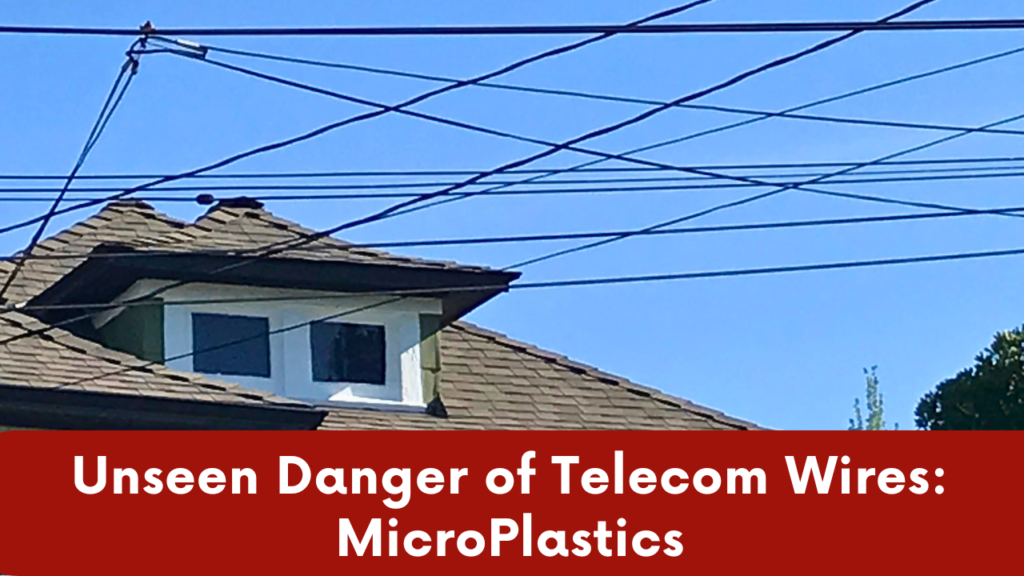
The Unseen Danger of Overhead Telecom Wires
Microplastic pollution is often associated with discarded plastic bottles, synthetic clothing, and cosmetic products. However, one lesser-known but significant contributor to environmental contamination is telecom cables. These cables, which crisscross our cities and rural landscapes, degrade over time, shedding microplastics into the air, soil, and water.
At Wire Free Sky, we specialize in removing outdated and unnecessary telecom wiring, Satellite dishes, and TV antennas. These telecom items can shed microplastics and lead into our environment, create visual clutter, and obstruct scenic views.
How Do Telecom Cables Shed Microplastics?
Telecom cables silently contribute to a growing microplastic problem. Most telecom cables, including those used for internet, telephone, and television services, are coated in a protective sheathing. These coatings serve an important function: they protect the wires inside from weathering, UV radiation, and mechanical damage.
However, regardless of the components of a telecom cable’s exterior, they succumb to UV deterioration over time.
Components of telecom cables protective exterior (aka jacket)
Unfortunately, the components of the various telecom cable’s protective exteriors, often called the jacket or sheathing, cause environmental damage once UV exposure causes the cable’s jacket to deteriorate. Below is a list of the typical components of the exterior or jackets of different types of telecom cables.
- CMX-rated Ethernet cable jackets are typically made with LLDPE (Linear Low-Density Polyethylene). It is considered UV Resistant, but like almost all compounds created to be UV resistant, that resistance deteriorates over time.
- Coaxial cable jackets typically consist of one of the following compounds: Solid Polyethylene, Foam Polyethylene, Foam Polystyrene, Air Space Polyethylene, Solid Teflon, or Air Space Teflon.
- Fiber Optics cable jackets typically contain one of the following compounds: polyvinyl chloride (PVC), polyethylene (PE), polyurethane, polybutylene terephthalate, or polyamide.
(Sources for jacket components: Truecable.com and Everythingrf.com.)
However, over time, these protective layers break down due to:
- UV Degradation – Sunlight gradually weakens plastic coatings, causing them to crack and flake.
- Abrasion from Wind and Movement – Cables sway in the wind and rub against trees, buildings, or other wires, shedding microscopic plastic particles.
- Temperature Fluctuations – Extreme hot and cold weather can cause plastic sheathing to expand and contract, leading to gradual deterioration.
- Animal and Insect Interference – Birds, rodents, and insects sometimes gnaw or nest around telecom cables, further breaking down the plastic.
As these factors take their toll, tiny fragments of plastic detach from the cables and enter the surrounding environment. Then, of course, once the protective jacket starts to degrade, the various plastic components of the cable itself start to shed into the environment.
Where Do These Microplastics Go?
Once released, microplastics from telecom cables disperse through multiple pathways:
- Airborne Particles – Wind can carry tiny plastic particles from overhead cables into the atmosphere, eventually settling into the soil and our waterways.
- Rainwater Runoff – Rain washes microplastics from cables into storm drains, rivers, and oceans, where they accumulate in aquatic ecosystems.
- Soil Contamination – Decaying overhead wires contribute to plastic buildup in the soil, affecting plant life and entering the food chain through crops and animals.
Studies show that microplastics are now found in everything from deep-sea sediments to drinking water. Telecom cables are an underrecognized source of this microplastic pollution. Although direct studies on microplastic shedding from overhead telecom cables are limited, related research highlights potential environmental concerns.
- Cell Towers Disguised as Trees Create Microplastic Pollution: The Environmental Health Trust reports how faux-tree cell towers, known as “monopines,” shed PVC plastic fragments over time. These fragments degrade into microplastics, contaminating surrounding land and water.
ehtrust.org - A Detailed Review Study on Potential Effects of Microplastics and Additives of Concern on Human Health: This comprehensive review emphasizes the environmental and health risks associated with microplastics and the hazardous chemicals they carry. It underscores the importance of understanding various sources of microplastics, which can include degrading plastic materials like those used in telecom infrastructure.
pmc.ncbi.nlm.nih.gov
These studies suggest that components of telecom infrastructure, especially those involving plastic materials – like those sheathing or jacket components listed above – contribute to microplastic pollution as they inevitably degrade over time.
The Hidden Danger of Lead in Old Phone Wires
Beyond microplastics, another serious environmental and health risk is lead contamination from old phone cables. Many older phone wires, particularly those installed before the 1980s, were coated in lead-based materials. As these wires deteriorate, lead particles can leach into the soil and water supply, posing a long-term hazard to both wildlife and human health.
Stay tuned! We’ll be diving deeper into this issue in an upcoming article about how old phone cables contribute to lead pollution and what homeowners can do to mitigate the risks.
Why Should You Care?
Microplastics and lead contamination pose risks to both environmental and human health. When ingested by marine life or animals, these pollutants introduce toxins into the food chain, eventually making their way to our plates. Additionally, some plastic coatings contain harmful additives like flame retardants and heavy metals, which can leach into ecosystems.
By removing outdated, abandoned, and deteriorating telecom cables, we can reduce one source of pollution while also reducing visual clutter and restoring views.
What Can Be Done?
At Wire Free Sky, we believe in proactive solutions:
- Remove Unneeded Cables – By eliminating abandoned telecom wires, we prevent further plastic shedding and reduce environmental impact.
- Encourage Sustainable Cable Materials – The telecom industry should invest in biodegradable or more durable alternatives that minimize pollution.
- Educate Homeowners & Home Improvement Contractors – Awareness is the first step in tackling this hidden issue.
Often, people don’t think about all the wires attached to their homes until they embark upon a home improvement project like installing new siding, putting on a new coat of paint, or other home improvement projects, which is why homeowners and contractors working together can create a more wire free sky. (Learn more about us by reading our FAQs.)
Conclusion
Telecom cables are often ignored, but their environmental footprint is real. The gradual shedding of microplastics and potential lead contamination contribute to our pollution crises that affect ecosystems and human health. Through responsible removal and sustainable practices, we can make a difference.
If you’re planning a home improvement project or simply want to eliminate unneeded telecom wiring on and around your home, Wire Free Sky is here to help.
Let’s work together to reduce microplastic and lead pollution, one cable at a time.
